Custom Design
Imagine this: You’re at a networking reception, and someone asks you, “What differentiates your business?” You muddle through an answer that sounds like any other business in your space. Ring a bell? Your unique value proposition may be hidden behind blankets of corporate jargon and industry buzz words.
A clearly defined unique value proposition becomes the foundation for your whole marketing approach. It’s the difference between having customers choose you above others or swiping through your content without giving it a second glance. When your UVP speaks to your audience on a deep level, it turns browsers into believers and makes your business a household name.
This page will walk you through tried-and-tested frameworks for creating, expressing, and executing a unique value proposition that breaks through market static. You’ll learn how to uncover your authentic differentiators, create effective messaging, and roll out your UVP across all customer touch points for most business impact.

Unique value proposition articulation is the strategic process for defining and conveying what makes your business uniquely valuable to your particular target market. It’s more than simply listing benefits or features – it’s about defining the very reason customers should buy from you instead of all other available options.
Consider your UVP to be your business North Star. It informs all marketing decisions, influences your brand communication strategy, and creates consistency in all interactions with customers. Properly defined, your unique value proposition is instantly recognisable and emotionally engaging.
Your UVP will have a direct effect on customer acquisition, rates of retention, and price power. Businesses that have well-defined value propositions tend to have 15-20% increased conversion rates and are able to charge premium prices since customers know exactly what value they’re getting.

Developing a strong unique value proposition creates a ripple effect throughout your entire business operations. Here’s why this strategic foundation becomes absolutely critical:
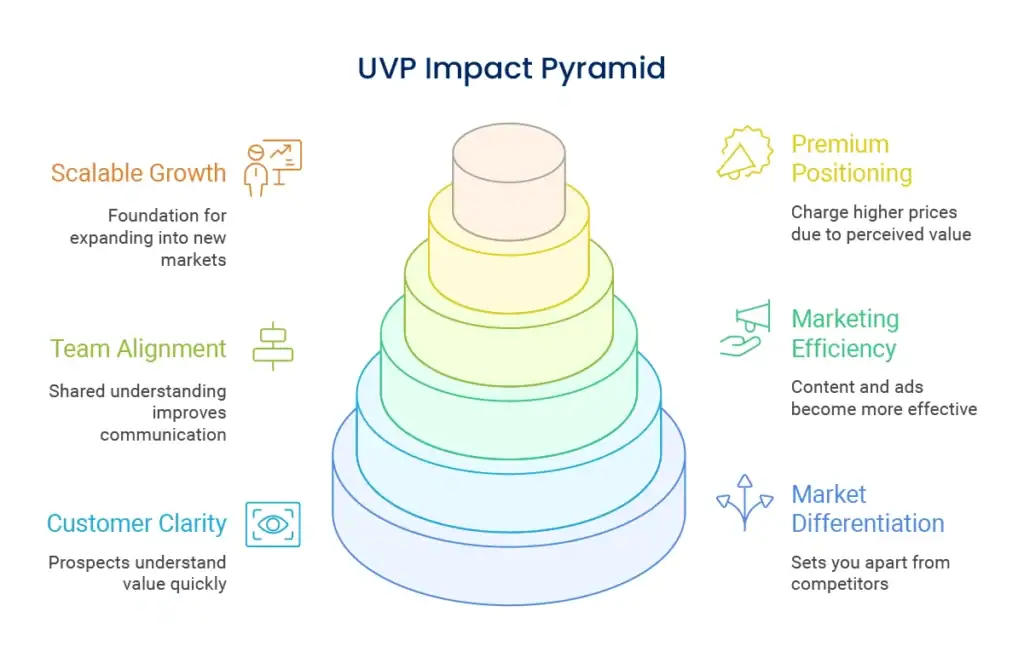
Your UVP separates you from competitors who offer similar products or services, giving customers a clear reason to choose your solution
When prospects immediately understand your value, they make faster purchasing decisions and experience less buyer's remorse
Every piece of content, advertisement, and sales conversation becomes more effective when built around a compelling value proposition
Your entire organisation rallies around a shared understanding of what makes your business special, improving internal communication and customer service
Well-articulated value allows you to charge higher prices because customers perceive greater worth in your offering
Your UVP becomes the foundation for expanding into new markets while maintaining brand consistency and customer trust
Companies that invest in proper strategic brand management and value proposition development often see 25-40% improvements in customer lifetime value because their messaging resonates more deeply with target audiences.
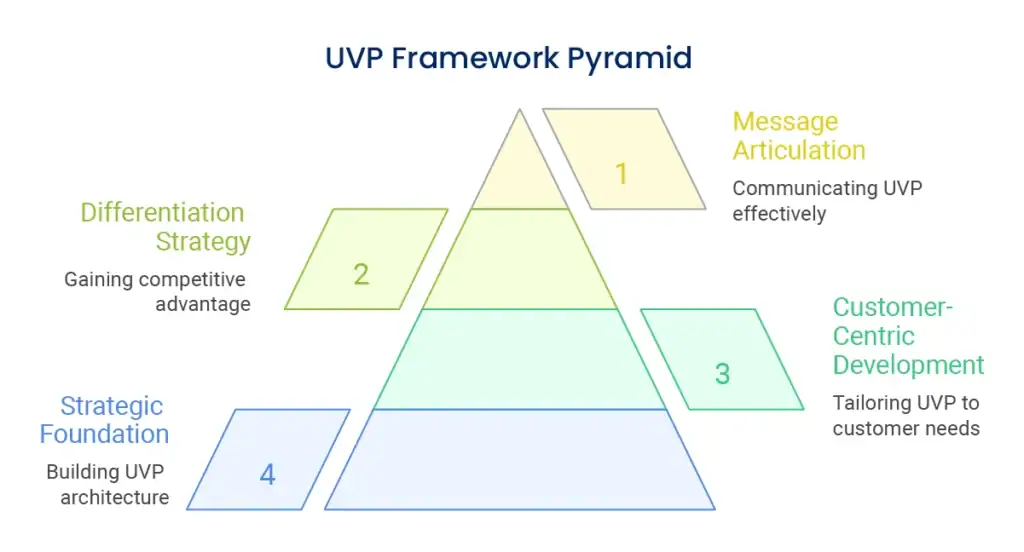
Your unique value proposition architecture starts with understanding three fundamental elements: your target customer’s deepest pain points, your solution’s unique capabilities, and the specific outcomes you deliver. This foundation requires honest assessment of your market position and competitive landscape.
Begin by mapping your customer’s journey from awareness to purchase decision. Identify the exact moments where they feel frustrated, confused, or uncertain. Your UVP should address these critical pain points while highlighting your solution’s distinctive approach.
Effective value proposition design always starts with your customer, not your product. Conduct deep research into your target audience’s language, concerns, and desired outcomes. The most compelling UVPs speak directly to customer needs using words and phrases your audience actually uses.
Create detailed customer personas that go beyond demographics. Understand their buying process, decision-making criteria, and the specific results they’re seeking. Your value proposition should feel like it was written specifically for each customer segment.
Your market differentiation strategy requires thorough competitive analysis to identify gaps in the marketplace. Study how competitors position themselves, then find the underserved areas where your business can create unique value.
Look for differentiation opportunities in service delivery, expertise areas, pricing models, or customer experience. The goal isn’t to be better at everything – it’s to be distinctly better at something your target customers truly value.
Crafting your value proposition message requires balancing clarity with compelling communication. Your UVP should be immediately understandable while creating emotional resonance with your target audience.
Test different message variations with real customers to identify which phrasing creates the strongest response. Focus on benefits and outcomes rather than features or processes. Your customers care about what your solution does for them, not how it works internally.
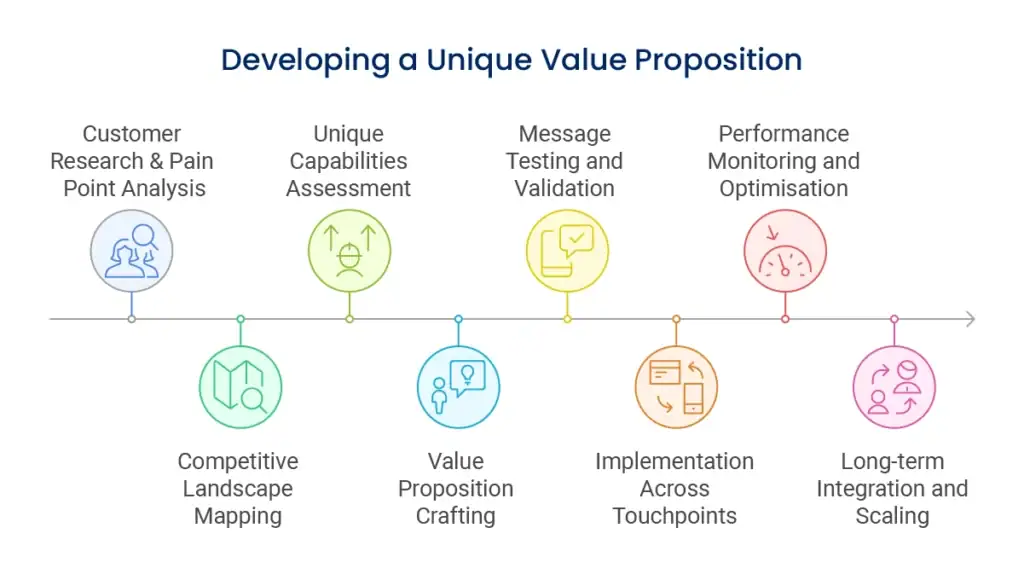
Begin by doing extensive research into your customer’s pains, frustrations, and unmet requirements. Survey them, interview them, and do market research to get actual data on what’s keeping your customers up at night.
Develop a comprehensive pain point inventory that moves beyond superficial issues. Explore the emotional and business consequences of these issues. Your unique value proposition must address the most prominent pain points that existing competitors have not fully resolved.
Analyse your competition’s value propositions, messaging, and market positioning. Identify patterns in how they communicate value and look for gaps where customer needs remain underserved.
Create a competitive positioning map that shows where each player focuses their value proposition. Look for white space opportunities where you can establish a distinctive position that competitors haven’t claimed.
Sincerely assess your business’s true strengths, capabilities, and expertise. Concentrate on the areas in which you can produce measurably better outcomes than options accessible to your customers.
Think about your team’s experience, proprietary approaches, technology strengths, or exclusive alliances. Your most compelling differentiators tend to arise from the blends of capabilities that others cannot mimic easily.
Write multiple versions of your value proposition using different approaches and messaging angles. Test variations that emphasise different benefits, use varying levels of specificity, or appeal to different emotional triggers.
Follow this basic structure: “We help [target customer] achieve [specific outcome] by [unique approach] so they can [ultimate benefit].” Refine this formula until it captures your distinct value clearly and compellingly.
Test your value proposition with real prospects and existing customers before finalising your messaging. Use A/B testing on landing pages, sales conversations, and marketing materials to identify which version generates the strongest response.
Gather feedback about clarity, relevance, and believability. Your UVP should immediately make sense to your target audience and create genuine interest in learning more about your solution.
Deploy your refined unique value proposition across every customer interaction point. This includes your website homepage, social media profiles, sales presentations, email signatures, and marketing materials.
Ensure consistency while adapting the message format for different channels and contexts. Your content marketing should reinforce your value proposition through every piece of content you create.
Track how well your value proposition performs across different channels and customer segments. Monitor conversion rates, customer feedback, and sales cycle length to identify improvement opportunities.
Regularly review and refine your messaging based on market changes, competitive moves, and customer feedback. Your UVP should evolve as your business grows and market conditions shift.
Embed your value proposition into your company culture and decision-making processes. Train your team to understand and communicate your UVP consistently across all customer interactions.
Use your unique value proposition as a filter for business decisions. New products, services, or partnerships should align with and strengthen your core value proposition rather than diluting it.

Apply A/B testing to your marketing channels to determine the performance of various value proposition messages. Test email subject line variations, landing page headings, and ad copy variations to determine the best messaging.
Monitor key metrics such as click-through rates, conversion rates, and time on page to measure your UVP’s performance. Establish accurate analytics and reporting to monitor performance on a regular basis.
Hold customer interviews and focus groups to dig deeper into the ways in which your value proposition resonates. Ask questions with specificity regarding clarity, relevance, and believability in order to determine improvement areas.
Listen to the words customers use when explaining your value. Customers will sometimes word your benefits in a manner that is more compelling than your original messaging.
Track your target audience’s reaction to your value proposition through various channels and settings. Measure engagement rates, quality of inquiries, and sales conversation results to determine whether your effort is effective.
Utilize social listening on social media and customer feedback to know how perceived your UVP is in the market. Seek ways to reinforce your messaging from actual market response.

Your website, social media profiles, and digital marketing materials should consistently communicate your unique value proposition. Ensure your digital marketing strategy reinforces your core value message across every channel.
Optimise your website’s user experience to highlight your value proposition prominently. Visitors should understand your unique value within seconds of arriving on your site.
Train your salespeople to communicate your value proposition clearly and persuasively. Create sales aids, presentations, and dialogue guides that reinforce your differentiated value along the entire sales process.
Develop concrete examples and case studies showing your value proposition in action. Actual customer success stories make your UVP more believable and persuasive.
Make sure your customer service staff knows and can effectively communicate your value proposition. Each customer interaction must reinforce the reason why they used your company and the continued value you offer.
Create service processes and communications that consistently fulfill your value proposition promise. Your customer experience must validate your UVP instead of contradicting it.
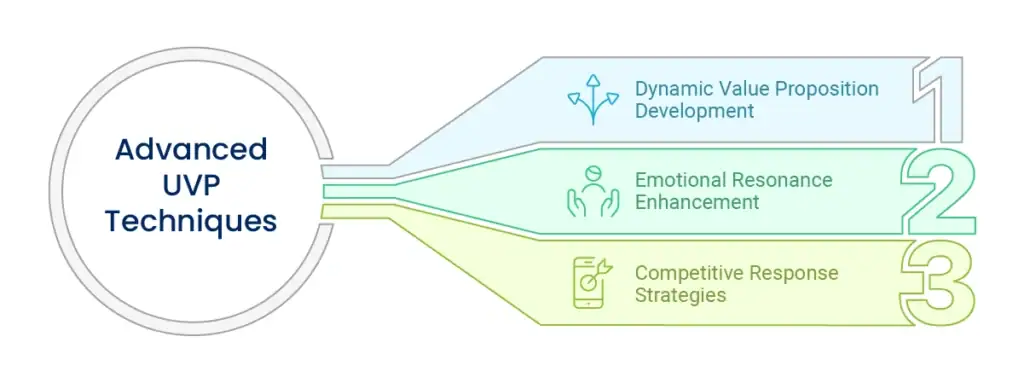
Look to create various value proposition options for a variety of customer segments or applications. As you maintain core consistency, you can highlight varying aspects of your value to multiple constituencies.
Design messaging frameworks that permit customisation while still maintaining your core value proposition. This practice permits more focused messaging without weakening your brand message.
Add emotional value to your functional value proposition to build richer customer connection. Get to know not only what your customers require, but also how they desire to feel when doing business with your company.
Create narrative strategies that help your value proposition be more memorable and easier to pass on. Stories elicit emotional responses that benefit statements alone cannot.
Prepare value proposition variations that respond to competitive threats or market changes. Having pre-developed messaging helps you respond quickly when competitors attack your market position.
Build defensive value propositions that highlight your unique strengths when competitors try to replicate your offering. Focus on differentiators that are difficult for others to copy.
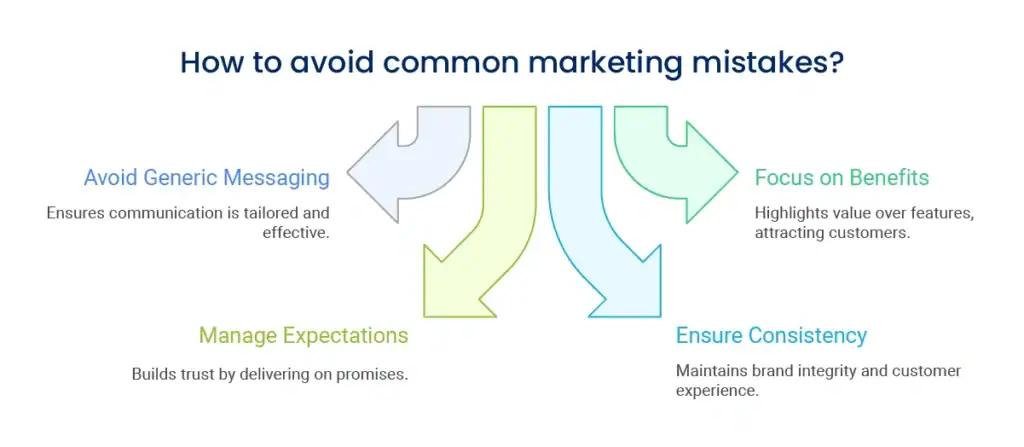
Most companies develop value propositions that might be true of any firm in their market. Steer clear of amorphous words such as “quality,” “service,” or “expertise” with no associated context or evidence points.
Try out your UVP by substituting your business name with a rival business name. If the sentence still holds water, your value proposition is not different enough.
Avoid the urge to enumerate product features rather than customer benefits. Your readers are interested in results and consequences, not technical details or process information.
Always link features to particular business and customer benefits. Enable your prospects to see “what’s in it for me” instead of how your solution works.
Ensure your value proposition accurately reflects what you can consistently deliver. Overstating your capabilities creates customer disappointment and damages your reputation.
Build credibility through specific, measurable claims rather than superlative language. Customers trust concrete benefits more than bold promises.
Many companies develop strong value propositions but fail to implement them consistently across all touchpoints. Inconsistent messaging confuses customers and weakens your market position.
Create implementation guidelines and training materials to ensure everyone in your organisation communicates your value proposition accurately and consistently.

Use customer survey platforms like Typeform or SurveyMonkey to gather feedback about your value proposition. Google Analytics and heat mapping tools help you understand how visitors respond to your messaging on your website.
Social media listening tools provide insights into how customers discuss your value and that of competitors. This intelligence helps refine your positioning and messaging.
Implement A/B testing tools like Optimizely or Google Optimize to test different value proposition messages. Email marketing platforms with testing capabilities help optimize your messaging across campaigns.
Use landing page builders with built-in testing features to quickly test different value proposition approaches and measure results.
Leverage content management systems that allow easy updating of your value proposition across multiple pages and touchpoints. Social media management tools ensure consistent messaging across all channels.
Consider using brand strategy development services to ensure your value proposition aligns with your overall brand positioning and market strategy.

Your unique value proposition becomes most powerful when integrated into every aspect of your business strategy. This means aligning your operational efficiency processes to deliver consistently on your value promise.
Consider how your UVP influences product development, service delivery, hiring decisions, and partnership choices. Every business decision should either strengthen your value proposition or, at minimum, avoid contradicting it.
Long-term value creation requires continuous refinement based on market feedback and changing customer needs. Your value proposition should evolve thoughtfully while maintaining the core differentiators that make your business unique.
Mastering unique value proposition articulation transforms your business from just another option into the obvious choice for your target customers. When you clearly communicate what makes your business distinctly valuable, you attract better customers, command higher prices, and build sustainable competitive advantages.
Your value proposition becomes the foundation for all marketing efforts, sales conversations, and customer experiences. It guides decision-making, aligns your team, and creates the clarity needed for scalable business growth.
Remember that developing an effective UVP is an ongoing process, not a one-time project. Stay connected to your customers’ evolving needs, monitor competitive changes, and continuously refine your messaging to maintain relevance and impact in your market.
The businesses that succeed long-term are those that can clearly articulate why they matter to their customers. Your unique value proposition is the bridge between what you offer and what your customers truly need – build that bridge well, and your business will thrive.
Developing a compelling unique value proposition requires deep market insight, customer understanding, and strategic thinking. If you’re ready to transform your generic messaging into market-winning differentiators, consider working with experts who specialise in strategic development and brand positioning strategy.
Professional guidance can accelerate your UVP development process and ensure your messaging resonates powerfully with your target market from day one.
Review your value proposition quarterly and update it when you introduce significant new capabilities, enter new markets, or face major competitive changes. However, avoid changing your core message too frequently, as consistency builds market recognition.
Minor refinements based on customer feedback and testing results can happen more frequently. Focus on improving clarity and impact rather than completely changing your positioning.
Yes, you can adapt your value proposition for different customer segments while maintaining core consistency. Emphasise different benefits or use segment-specific language, but ensure all variations support your overall brand positioning.
Avoid creating completely different value propositions that contradict each other. Your variations should feel like natural extensions of your core value rather than separate identities.
Track conversion rates, customer acquisition costs, sales cycle length, and customer lifetime value to measure your UVP’s business impact. Monitor brand awareness and preference through market research and customer surveys.
Customer feedback quality, referral rates, and pricing power also indicate how well your value proposition resonates with your target market.

Enter your email to get instant access